New Orleans, LA - 2015
Updated:
07/25/16
 This
was our first visit to New Orleans. It was a city we wanted to visit for three
reasons - see the French Quarter, walk through a cemetery and eat a biegnet
(French donut). We had no desire to participate in the nightlife of New Orleans.
We were careful to follow the recommendations of the 'people in the know' as to
areas to visit, areas not to visit, even in the daytime. That being said, we
enjoyed our day in New Orleans.
This
was our first visit to New Orleans. It was a city we wanted to visit for three
reasons - see the French Quarter, walk through a cemetery and eat a biegnet
(French donut). We had no desire to participate in the nightlife of New Orleans.
We were careful to follow the recommendations of the 'people in the know' as to
areas to visit, areas not to visit, even in the daytime. That being said, we
enjoyed our day in New Orleans.
We encountered more traffic than we were used to - we have been traveling
two-lane roads with little traffic. And, as retirees, we avoid traffic as much
as possible.

 Without
our GPS, we would not have found our campground. Even with the GPR, a street on
our route was parallel and too close to another for the GPS to identify it so we
missed our turn.
Without
our GPS, we would not have found our campground. Even with the GPR, a street on
our route was parallel and too close to another for the GPS to identify it so we
missed our turn.
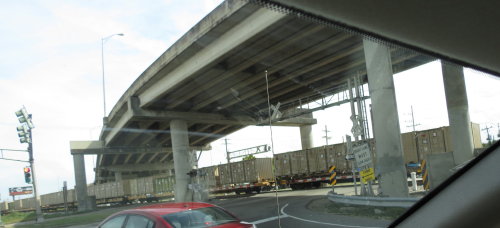 We
should have turned right toward the train.
We
should have turned right toward the train.
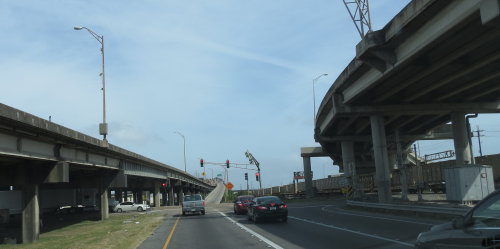
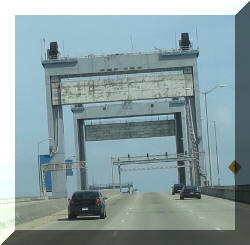
Instead, we ended up on the overpass over the train tracks.
We recovered
quickly after a u-turn in a neighborhood.
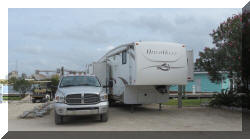 Our
campsite backed up to the canal leading to the marina. The campground was in a
marina/boatbuilding/industrial area. Approaching the campground we wondered if
the recommendations we received were on target. The recommendations were spot
on. (We know because as we were leaving New Orleans, we saw some of the other
campgrounds we considered . . . using them would have been a mistake.)
Our
campsite backed up to the canal leading to the marina. The campground was in a
marina/boatbuilding/industrial area. Approaching the campground we wondered if
the recommendations we received were on target. The recommendations were spot
on. (We know because as we were leaving New Orleans, we saw some of the other
campgrounds we considered . . . using them would have been a mistake.)
A walkway next to our site ended at a floating ramp to a floating dock.
Several floating rental cabins were located along the floating dock.



We had time for a short ride around the area before dark. The counter gal at
the camp office gave us 'easy' directions to the city park. We got lost ... or
... at least did not find the park. In our opinion, people in New Orleans are
scary drivers and ignore stop lights. (Later, we found out that we were just a
block away.)

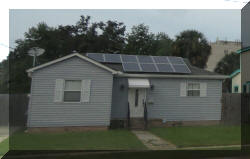
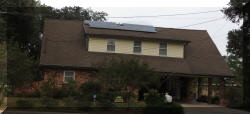
We saw houses with tiles and several with solar panels on their roof.
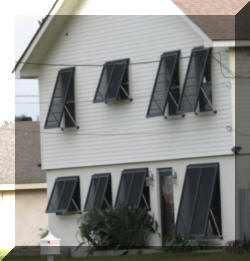
Several had storm coverings for their windows.
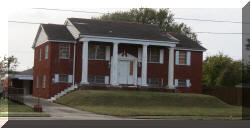

Houses were built on mounds of dirt or concrete risers.

This one had decorative security bars.
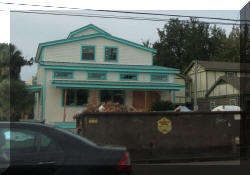
Many houses were being renovated.
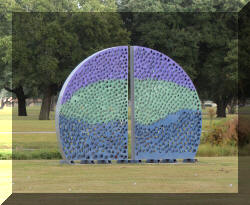 This
art work was in a small park near the campground.
This
art work was in a small park near the campground.
A statue of General Beauguard, who fired the first shot at Fort Sumpter,
stands outside the entrance to the City Park. The general was a Louisiana born
Confederate general during the Civil War. His nickname was "Napoleon in Gray".

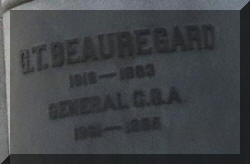
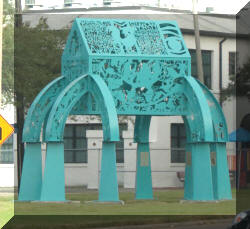 Sculpture on grounds of The New Orleans Museum of Art.
Sculpture on grounds of The New Orleans Museum of Art.
The next morning we took the 10:00am shuttle to the French Quarter.

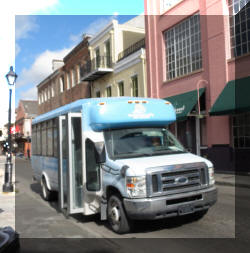 For
six dollars (roundtrip) each, we could ride the campground's French Quarter
shuttle. The last pickup in the French Quarter was 6:00pm. If you missed it, you
had to find your own way back to the campground.
For
six dollars (roundtrip) each, we could ride the campground's French Quarter
shuttle. The last pickup in the French Quarter was 6:00pm. If you missed it, you
had to find your own way back to the campground.

Our drop-off and pick-up point . . .
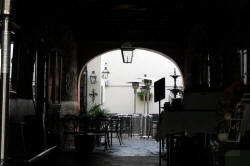 An
interior courtyard also know as a patio, between buildings, are now part of
restaurants rather than the private residences.
An
interior courtyard also know as a patio, between buildings, are now part of
restaurants rather than the private residences.
As we approached Decatur Street, an officer blocked traffic for a tour bus.
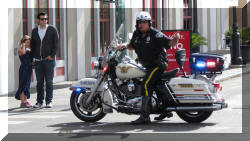

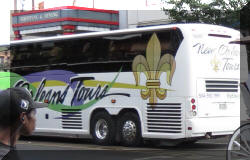
If you did not want to walk, you had transportation choices.
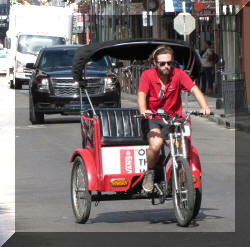
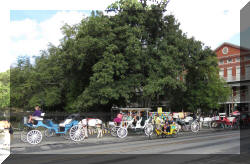
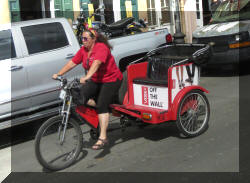
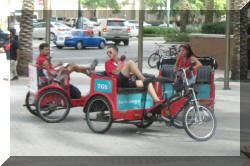
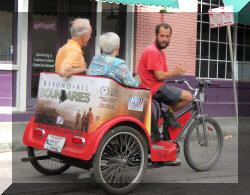
 Knowing
we wanted to take a bus tour of the city, we headed for the Lighthouse Ticket
Office to purchase our tickets. It is an attractive round building on the
waterfront. We selected the Gray Line All-City Tour because it included the
areas we wanted to see and a stop at St Louis Cemetery #3.
Knowing
we wanted to take a bus tour of the city, we headed for the Lighthouse Ticket
Office to purchase our tickets. It is an attractive round building on the
waterfront. We selected the Gray Line All-City Tour because it included the
areas we wanted to see and a stop at St Louis Cemetery #3.
 It
was too early for lunch at this place across from the ticket office.
It
was too early for lunch at this place across from the ticket office.
After purchasing our tickets, we headed back to Decatur Street for our fresh
beignets. Looking left and straight provided views of new and old buildings.




The VooDoo Store . . .
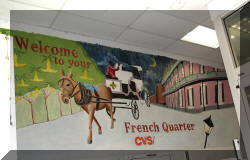
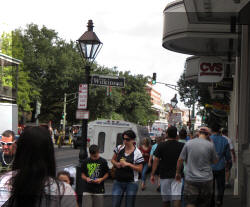 The
small CVS sign hangs in front of the 15' wide store.
The
small CVS sign hangs in front of the 15' wide store.
The mural was in the CVS entryway. >>>
The store was small but they had a business presence in the
French Quarter.
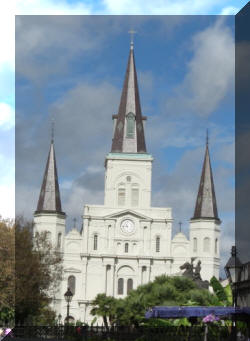
The
Cathedral-Basilica of St. Louis, King of France
 Visitors can take various steamboat cruises while visiting New Orleans.
Visitors can take various steamboat cruises while visiting New Orleans.
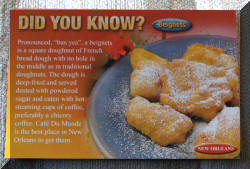 We made our way to the place that sold the "best" beignets in town - Cafe Du
Monde, Original French Market Coffee Stand.
We made our way to the place that sold the "best" beignets in town - Cafe Du
Monde, Original French Market Coffee Stand.
Mary Lou got in the line on the sidewalk in front of us. After standing there
for a while, she was told that it was the line for a table inside the restaurant
- the wait was too long.
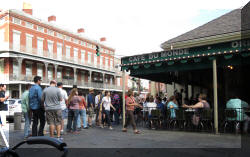

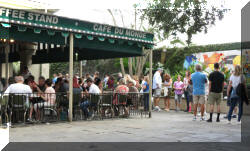
So, she moved to the 'takeout' line on the right. It was longer than the
'inside' line. Based on the slow movement of this line, she decided the wait was
too long.
We back-tracked to a place we had seen where the line was only about ten
people deep. Their restaurant area was quite busy and their fresh beignet's were
very good.
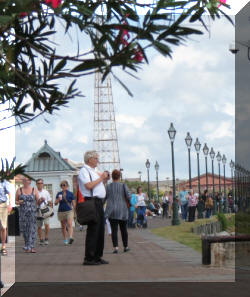 Water
draws us to it. So, we took a side street back to the Mississippi River
boardwalk.
Water
draws us to it. So, we took a side street back to the Mississippi River
boardwalk.
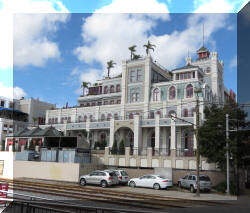
Hotel with palm trees on roof . . .

Looks like a building on a building . . .
 Ships
under construction . . .
Ships
under construction . . .

Barge on the river . . .
 Robert
Schoen's Old Man River sculpture is a stylized stone human figure made of 17
tons of Carrara marble.
Robert
Schoen's Old Man River sculpture is a stylized stone human figure made of 17
tons of Carrara marble.
STARTING THE ALL-CITY BUS TOUR . . .
As we were leaving on our All-City bus tour, the driver told
us the flower bed in front of us did not have a fence around it originally. So,
people would walk through it. The city installed a 12" fence to eliminated that
- people stepped over the low fence. This three foot fence was installed. It has
been effective keeping people out of the flower bed.
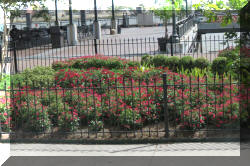
He also pointed out the flood wall, flood gate and one of the trolley cars.
There were several trolley lines in New Orleans - the one you see here is a
Capital City Trolley.


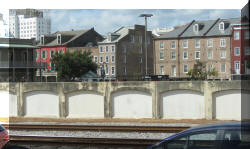


Flood walls and flood gates are designed to protect the city from a rising
Mississippi River.
 Monument
to Immigrants . . . At the turn of the century many Italian immigrants came to
this country, a large number of them through the port of New Orleans. It is made
of white carrara marble and is created by local sculptor Franco Allesandrini.
Monument
to Immigrants . . . At the turn of the century many Italian immigrants came to
this country, a large number of them through the port of New Orleans. It is made
of white carrara marble and is created by local sculptor Franco Allesandrini.
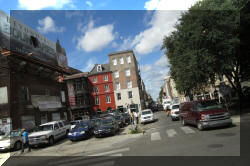
 Bienville Statue: Jean Baptiste La Moyne de Bienville founded New Orleans in
1717. He served as governor for a total of four years.
Bienville Statue: Jean Baptiste La Moyne de Bienville founded New Orleans in
1717. He served as governor for a total of four years.
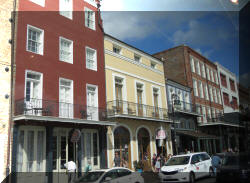
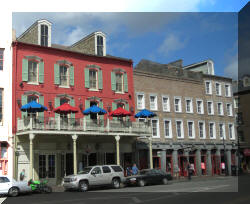 Gallery
and balconies . . .
Gallery
and balconies . . .
<<< This is a Galleiy.
These are balconies >>>
Do you see the difference?
Galleries are supported by posts.


Some are decorated with flowers, some are just very decorative.
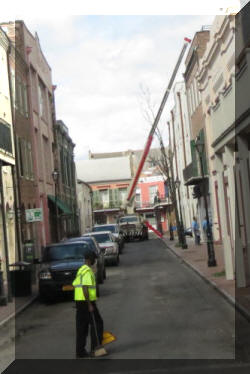 The
streets are very narrow ... but ... renovations must go on.
The
streets are very narrow ... but ... renovations must go on.
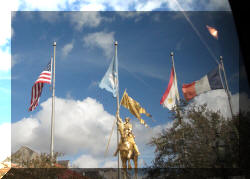 The
people of France gave the golden bronze statue of Joan of Arc to the City of New
Orleans in 1972. (Note: This statue is an exact copy of the famous 1880 Emmanuel
Fremiet equestrian statue of Joan located at Place des Pyramides, Paris.) This
statue was originally located in front of the International Trade Mart building
but it was moved in 1999 to its present location of the 'Place De France" in the French Quarter next to the French Market on Decatur
Street.
The
people of France gave the golden bronze statue of Joan of Arc to the City of New
Orleans in 1972. (Note: This statue is an exact copy of the famous 1880 Emmanuel
Fremiet equestrian statue of Joan located at Place des Pyramides, Paris.) This
statue was originally located in front of the International Trade Mart building
but it was moved in 1999 to its present location of the 'Place De France" in the French Quarter next to the French Market on Decatur
Street.
French Market . . .




Mobile fruit and vegetable trucks
sell in the neighborhoods.

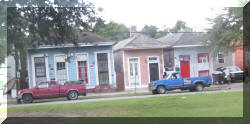 Some
areas of New Orleans have very colorfully painted houses.
Some
areas of New Orleans have very colorfully painted houses.
The Haitian's used the brightest colors - in their culture it indicated
wealth.

ST LOUIS CEMETERY #3 . . .
Established in 1854, each tomb recounts a chapter in New Orleans' rich
history—from immigration patterns, to floods and yellow fever outbreaks. We
walked the rows of marble and stone gravesites.
The cemeteries are often referred to as "cities of the dead". New Orleans has
45 cemeteries - 31 are considered historic, and 5 are officially listed in the
National Register of Historic Places. Due to vandalism, some are only
open to organized tours.

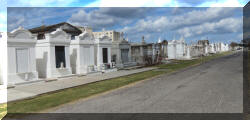


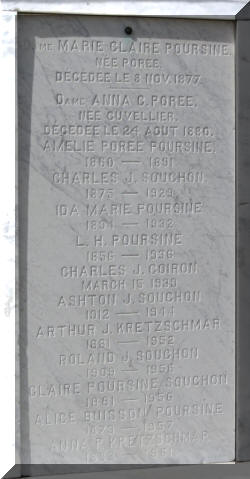 The
story of how New Orleans handles the limited space for burials caused by a high
water table is very interesting.
The
story of how New Orleans handles the limited space for burials caused by a high
water table is very interesting.
When a family member is ready for burial, the front is
taken off the tomb. Most tombs have chambers for two bodies in caskets. By law,
the body cannot be disturbed for one year and one day so decomposition can
occurred.
The prior body is placed in a biodegradable bag and placed
elsewhere in the crypt. The new body is laid to rest in the burial chamber, then
the tomb is resealed. The new resident's name is added on the front panel.
The cemetery provides holding crypts should there be
too many bodies to buried at one time.
When the tomb is sold, the panel with the prior names is moved to the side of
the tomb. The cemetery disposes of the prior bags and contents. New owner's
names are added to the new front panel as they are buried.
Tombs sell for from $12,000 for concrete to $35,000 for a small marble or
granite one.
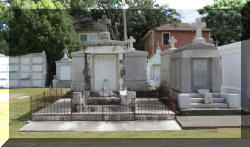
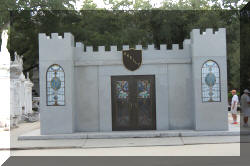

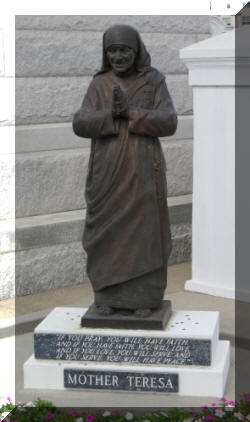

This wall of vaults is from 1854, the oldest in the cemetery. The owners are
responsible for maintaining the front of the vaults.
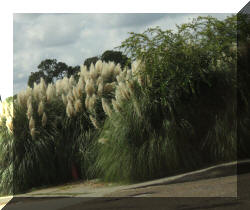
The decorative grass grows extremely tall.
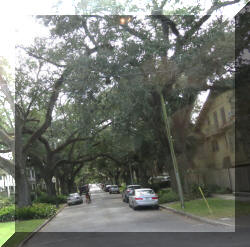 One
of a few wide residential streets.
One
of a few wide residential streets.
CITY PARK . . . A 1,300 acre city park. (The city park was a stop on
the All-City bus tour.)

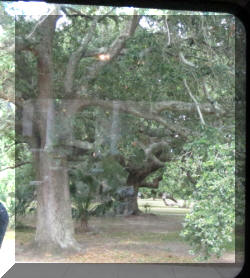
This is the McDonogis Oak, the largest and oldest oak tree in New
Orleans' City Park. The oak's circumference is more than 25 feet, and its crown
spread is more than 150 feet.
Besthoff Sculpture Garden . . . (within the city park)

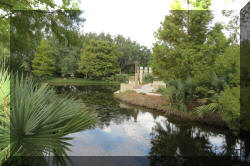


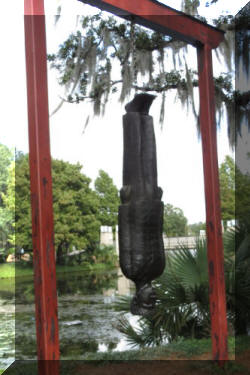
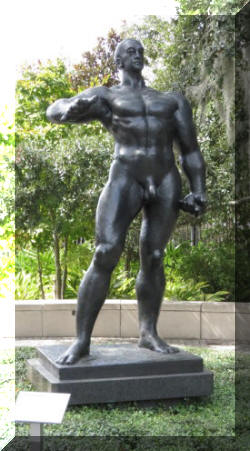
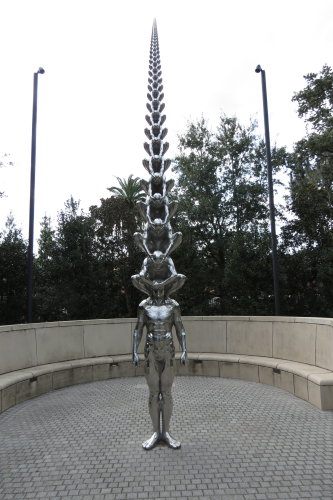

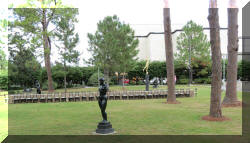


Table set up for a party . . .
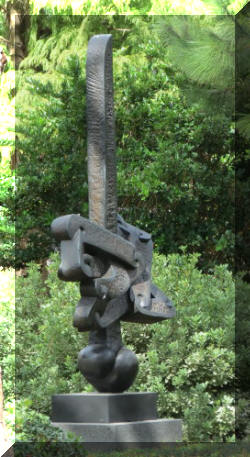
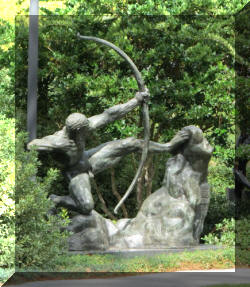
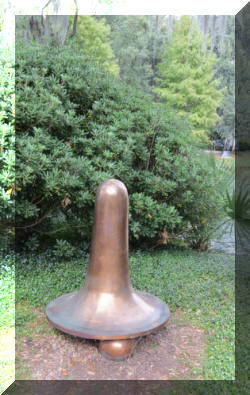
We grabbed a 'highly recommended' hot dog in the concession building across
from the sculpture garden prior to boarding the tour bus.

In the distance, on the grounds of the city park,
is the New Orleans Museum
of Art.

 End
of the green line . . .
End
of the green line . . .
Loyola University . . .
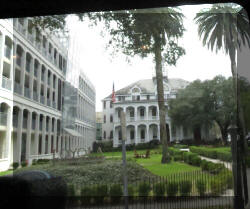


A house decked out for Halloween . . .
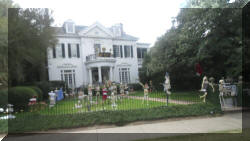
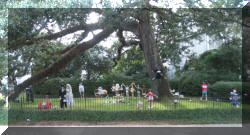
Some homes were huge . . .
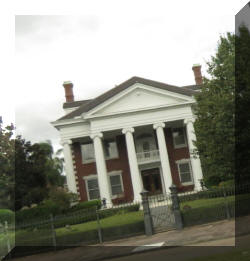

Beads from Mardi Gras that didn't hit their target. The beads thrown from the
parade floats symbolize the throwing of "wealth" to the peasants.

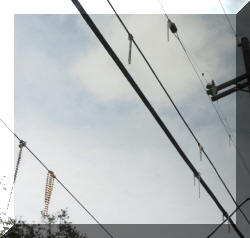
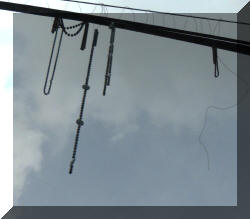
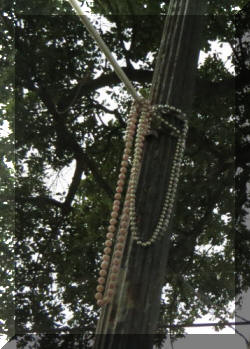

New Orleans had a mix of building architecture . . .
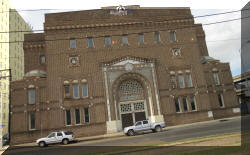


Statues adorned the 'neutral ground'. (We would call it the median.)
This
is where two ethnic neighborhoods met.


 Like many older, high density cities, New Orleans has many narrow, one-way streets.
Like many older, high density cities, New Orleans has many narrow, one-way streets.
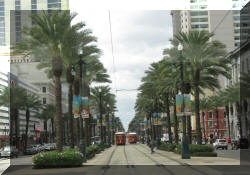
This looks like the Red Line coming at us . . .
THE END OF THE ALL-CITY BUS TOUR . . .
We spent our time waiting for the shuttle pickup at the Mississippi River
waterfront.
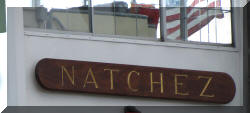



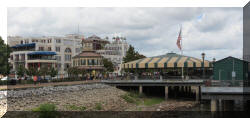
Covered boat dock waiting area . . .
 This day, the Woldenberg Riverfront Park Shelter was the site of a fundraising
group promoting the need for footwear for the poor, participants walked barefoot
to raise funds.
This day, the Woldenberg Riverfront Park Shelter was the site of a fundraising
group promoting the need for footwear for the poor, participants walked barefoot
to raise funds.

Get a room!
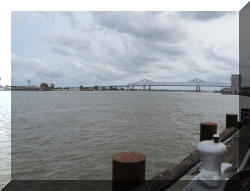



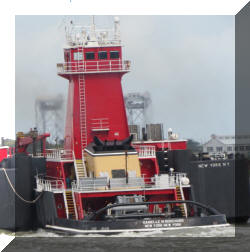
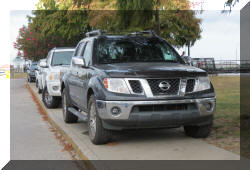
Parking is at such a premium by the waterfront,
permits can be obtained to
park on the sidewalk.
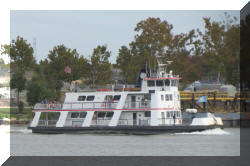

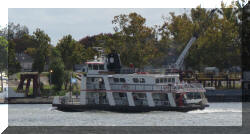
This ferry crossed the river every twenty minutes.
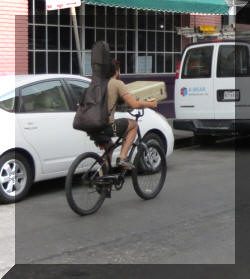
Musician heading for his evening's gig . . .
Mail/supply delivery boat . . .
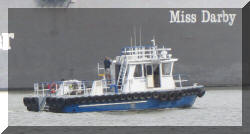


Street performer . . .
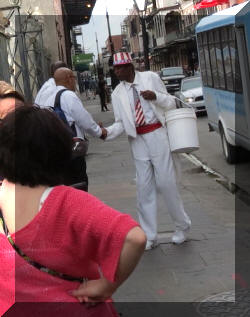

The last night, we had dinner in the campground restaurant.
Mary Lou
shared some of her dessert - pecan pie.
Departure morning was WET. Hurricane Patricia was heading our way. We did all
the prep we could inside and continually watched weather radar on our phones. It
did not look good except for a small hole in the huge rain pattern.

The rain did not seem to bother some boaters.



When a small break in the rain arrived, we moved fast. We completed our
outside work and splashed our way out of the campground.
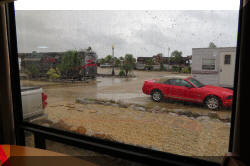
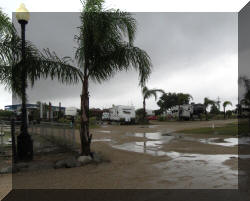
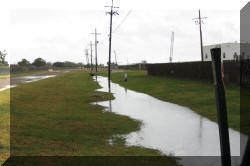
Heavy clouds hung over the entire New Orleans area.
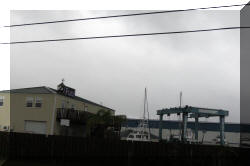


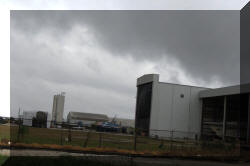


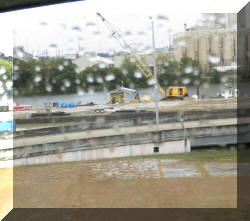
On the road again . . . it was WET and cloudy all day. We drive
through or stayed ahead of the worst of the rain.

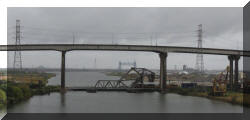
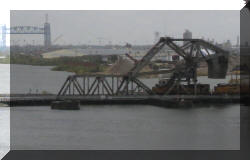

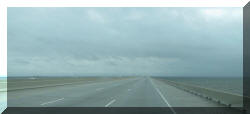

We were very fortunate that we visited the French Quarter and
the rest of New Orleans the day before. We had a fantastic day with beautiful
weather.
Mary Lou had two major objectives: eat a biegnet and walk through an
old cemetery. Those accomplished, she could leave New Orleans satisfied with her visit.
Top of Page
Go back to:
Louisiana - 2015
 This
was our first visit to New Orleans. It was a city we wanted to visit for three
reasons - see the French Quarter, walk through a cemetery and eat a biegnet
(French donut). We had no desire to participate in the nightlife of New Orleans.
We were careful to follow the recommendations of the 'people in the know' as to
areas to visit, areas not to visit, even in the daytime. That being said, we
enjoyed our day in New Orleans.
This
was our first visit to New Orleans. It was a city we wanted to visit for three
reasons - see the French Quarter, walk through a cemetery and eat a biegnet
(French donut). We had no desire to participate in the nightlife of New Orleans.
We were careful to follow the recommendations of the 'people in the know' as to
areas to visit, areas not to visit, even in the daytime. That being said, we
enjoyed our day in New Orleans.
 We
should have turned right toward the train.
We
should have turned right toward the train.
























































 Some
areas of New Orleans have very colorfully painted houses.
Some
areas of New Orleans have very colorfully painted houses.




































































